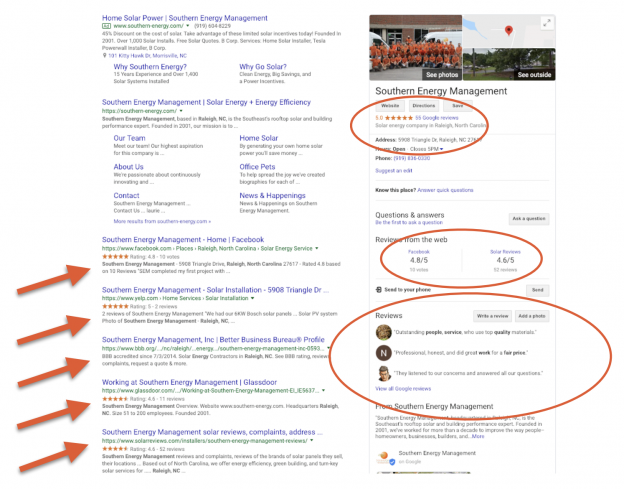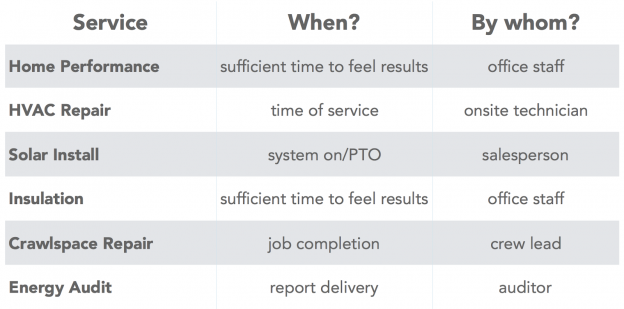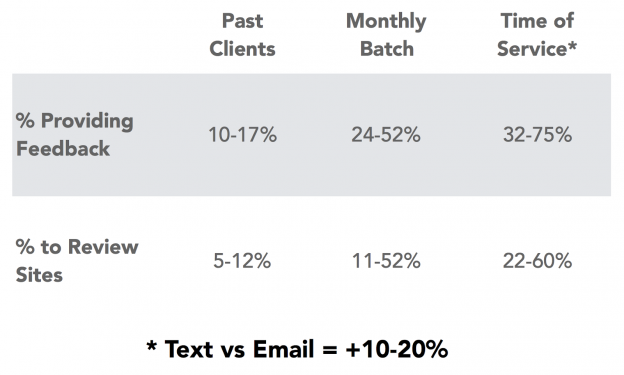
As you may know if you caught our most recent webinar about review management, collecting reviews from third party websites like Google, Facebook, and Yelp is more important than ever for the success of an HVAC, home performance, or solar business. Reviews have steadily been gaining ground as a ranking factor in search, and the minimum number of Google reviews your business should have is quickly rising.
Meanwhile, third party reviews have a growing presence in search results. A brand search for your company will likely pull up multiple third party review sites in results — plus a Google My Business profile with multiple mentions of reviews:

Reviews are more prominent than ever, taking up significant real estate in both organic search results and in the Google My Business profile.
The bottom line is that now is the time to start upping your review management game if you haven’t already. In addition to growing the number of Google reviews you have, it’s also important to aim for diversity in reviews by getting reviews on other third party sites like Yelp, Facebook, Better Business Bureau, Home Adviser, and Solar Reviews.
How Many Customers Actually Write Reviews?
As it turns out — and this will likely come as no surprise — customers who write reviews are not so common. According to GatherUp, a review management system we use, 78% of customers never leave reviews, while another 16% leave just one to five reviews a year. Only about 6% of customers leave six or more reviews per year.
Keep in mind that these numbers may vary depending on the quality of the work and service you offer. According to the same GatherUp study, for example, higher quality work tends to garner more reviews — as much as six times more reviews, in fact. Ultimately, the takeaway here is that you, as a company, need to prioritize work quality and develop a process where you are consistently asking your customers for feedback.
Best Practices When Asking for Reviews
Many contractors ask us “Which review management software should I use?” Our reply: it depends. There are a number of great systems out there for streamlining your review management process, and the one you choose will depend on how you want to request feedback (via email, text, etc.) and how you want reviews to appear on your website (via a widget, an iframe, etc.) Our advice is to choose a software that serves your needs and to have someone in charge of soliciting feedback and reviews for your company.
Also be sure to remember these “best practice” tactics:
Ask everyone for feedback
Create a “culture of customer feedback” at your company, where you are asking every single customer for feedback. This does not necessarily mean asking every single customer to review you publicly; but it does mean asking everyone you work with to tell you how you did, be it through private or public feedback.
Allow for direct feedback or a third party review
Some customers will prefer to provide direct feedback to you, while others will prefer to leave an online review on a third party site like Google, Facebook, or Yelp. Give your customers both options. Any positive feedback you receive can be published as a testimonial on your website, while of course a positive online review will help strengthen your online presence.
Limit third party choices
When asking for a third party review, limit it to just one review site. Our experience is that you are more likely to get that online review if you specify one review site rather than offering up several options.
Utilize Net Promoter Score
Net Promoter Score (NPS) is a simple metric you can use to gauge how likely you are to receive a positive online review from a customer. You can calculate your NPS by asking customers “How likely are you to recommend [company] to a friend or neighbor?” — where 0 represents “not at all likely” and 10 represents “extremely likely.” Those who answer with a 9 or 10 are called Promoters; those who answer with a 7 or 8 are called Passives; and those who answer with a 0 to 6 are called Detractors.
Your NPS is your percentage of Promoters minus your percentage of Detractors.

Calculate your Net Promoter Score by asking customers how likely they are to recommend you to a friend or neighbor — and then subtracting the percentage of Detractors from the percentage of Promoters.
NPS can range from -100 (if you get all Detractors) to 100 (if you get all Promoters.) Of course, if you have a higher NPS, you are more likely to garner positive online reviews. If you have a low NPS, you should probably prioritize improving your work and service quality before soliciting online reviews.
When to Ask a Customer for a Review
Past customers
If you’re looking to up your review game, a great place to start is to survey your list of past customers and ask those customers to leave you an online review. Of course, this list will contain customers from 10 years ago as well as customers from a week ago; so you may want to organize who you ask into “batches” based on time period. It may also be helpful to organize your list by service, and then prioritize those services by recency and seasonality. Focus on capturing a broad range of reviews and testimonials that correspond with current demand and trends in your industry. If you’re an HVAC contractor, for example, as we enter in the hottest months of the year, you could prepare a “review request” email for past AC installation customers, with messaging like, “Thank you for choosing us to install your air conditioner. We’d love to hear how your experience was…”
Current customers
As you finish mining that list of past customers, you should create a system for asking current and future customers for feedback. You might adopt a “batch” process, where you collect your customers from the past week or month and contact them all at once about leaving a review; or, you might adopt more of a “time of service” process (more on that below.)
“Time of service” customers
Sometimes, it is best for the employee who performs the service to ask the customer for a review at the time of service. Keep in mind that this is not true across the board for all HVAC, home performance, and solar services. Here are a few suggestions on which services might be best suited for the “time of service” scenario:

For certain services, it is best to ask a customer at the time of service to leave you an online review.
For services like an HVAC repair or crawlspace repair, it is generally best for the onsite technician or crew lead to ask the customer for a review at the time of service. For home performance services like insulation, on the other hand, it makes more sense for a member of the office staff to ask for a review after the customer has been given sufficient time to experience some results. Meanwhile, for solar installs, we’ve seen more success with a salesperson asking the customer for a review when the system is turned on.
As you establish a system for soliciting reviews at your company, be sure to think about the types of services you offer. Do those services lend themselves best to asking for a review at the time of service, or would it make more sense to ask the customer for a review after they can see the results of the service? In addition, consider which employee has developed the strongest relationship with the customer you wish to ask for a review.
What to Expect When You Ask for Reviews
As you can imagine, your success rates will vary depending on which customers you are asking to review you. Here’s what our data tells us:

In this table, “Past Clients” refers to past customers you retroactively ask for feedback. “Monthly Batch” refers to recent customers you follow up with to ask for feedback. “Time of Service” refers to customers you ask for feedback at the time of service.
According to our data, only about 10% to 17% of past clients are willing to give feedback, while even fewer — just 5% to 12% — are willing to leave an online review. Meanwhile, about 11% to 52% of recent “monthly batch” customers are willing to leave an online review. Customers you ask to review you at the time of service are the most likely to provide feedback, with 22% to 60% willing to leave an online review. Finally, we’ve noticed that asking certain customers for a review via text can up your chances of receiving an online review even further.
The takeaway here is that when you ask for reviews at the right times (and by the right means), you are more likely to receive online reviews.
There’s No Substitute for Quality Work
After all this talk about review management, remember that no process can substitute for high quality work and good customer service. Great work earns great reviews; and when you have the right review management system in place, you can convert once-shy customers into glowing promoters of your business.